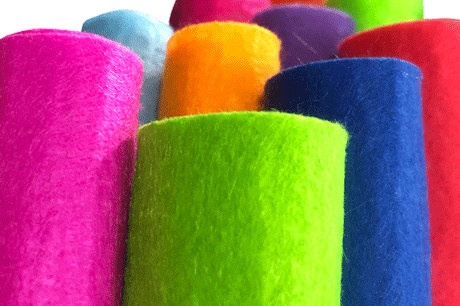2. Air stretch of nascent fiber
In order to improve the performance of the nonwoven fabric, it is also necessary to stretch the orientation of the nascent fiber to increase the orientation and crystallinity of the fiber, thereby improving the physical and mechanical properties of the fiber. In the production of spunbonded nonwoven fabrics, since the subsequent processes such as spinning, drawing, splitting, laying, and reinforcement are continuous and high-speed, the stretching of the fiber is completed in a short time, and the fiber Provides ideal cooling effect, so the production of spunbonded nonwovens mostly adopts air stretching.
The principle of the air-flow drawing process: the thread is extruded from the spinning hole and cooled by the side blowing, and then directly sucked into the suction port of the air-drawing equipment. In the airflow duct of the stretching equipment, the stretching airflow is blown in by the direction of the fiber, and the fiber is rapidly accelerated under the clamping action of the high-speed and high-pressure stretching airflow, and the stretching is achieved through the stretching nozzle. Air-flow stretching equipment mainly includes tubular drafting machine, narrow-slit drafting machine and wide-slit drafting machine.
The control of the airflow stretching process is mainly through the structure of the drafting machine (under the condition of constant air volume, the smaller the drafting nozzle and the air duct, the higher the drafting speed and the higher the fiber strength), the wind temperature of the drafting wind, and the drafting Wind pressure and wind speed, cooling conditions.

3. Fiber formation
Fiber-forming is a process in which continuous filaments formed after melt spinning and air-stretching are subjected to filament separation, so that the monofilaments are evenly dispersed, and then laid on a mesh curtain to form a uniform web. For the forming process of spunbonded nonwoven fabrics, due to the use of continuous filaments to form a web, the time for dividing and laying the web is short, and the high-speed drawing airflow is severely disturbed, so it is difficult to control the movement of the fiber filaments and affect the fiber formation. Therefore, the spunbond process cannot form thin nonwoven fabrics.
The web-forming process of the fiber first needs to split the fiber filaments that have been stretched by the airflow. The purpose is to separate the tow into single filaments to prevent fiber adhesion during web laying and affect the uniformity of the web . Separation methods mainly include electrostatic separation method, mechanical separation method, and airflow separation method. The fiber filaments after the separation process are evenly laid on the netting curtain by different processes to form a non-woven fiber web. The web-laying process needs to control the movement of the fiber filaments according to the set trajectory, so as to ensure that the formed web is firm and uniform. The movement of fibers can be controlled by mechanical and airflow methods. Therefore, the methods of laying nets mainly include pen laying, breaking laying, jet laying and runner laying, etc. In the process of laying the net, in order to quickly fix the structure of the web and avoid the influence of external factors, the method of negative pressure laying is adopted, that is, in the space under the netting curtain, vacuum suction is used to form the net. The upper surface of the curtain generates negative pressure, thereby promoting the collection and fixation of the fiber filaments. On the one hand, the method of negative pressure laying has a certain stretching effect on the fibers, and on the other hand, it can dissipate the high-speed airflow from the tubular drafting machine and prevent the fibers from scattering due to violent airflow disturbance. Therefore, in the process of laying the net, the requirements for the fiber netting curtain are relatively high. The netting curtains often require good air permeability, high tensile strength, sufficient curtain width and good antistatic performance, and It is also equipped with a mesh curtain sealing device to meet the requirements of brackets, transporting webs and separating airflow.
The above information is provided by anti slip felt factory.